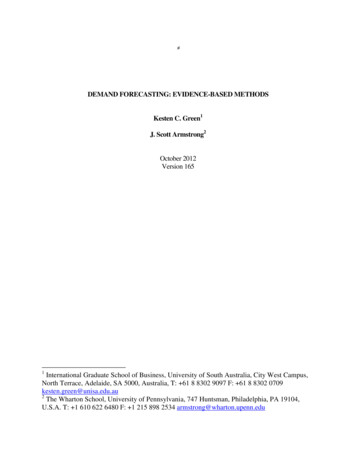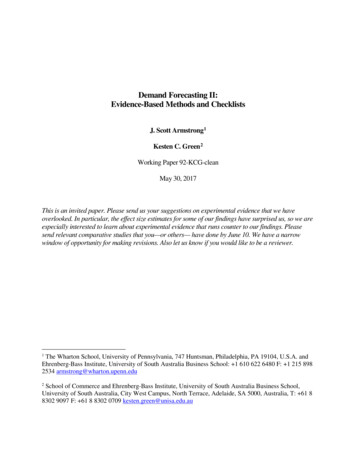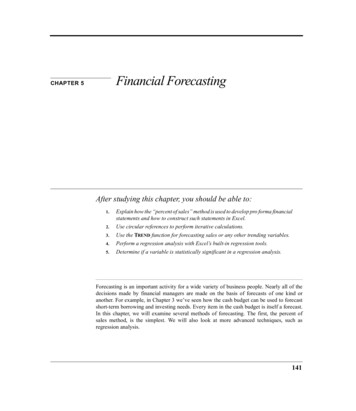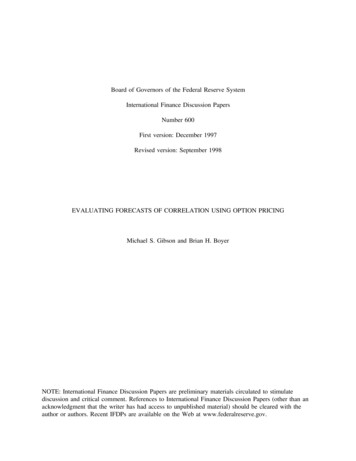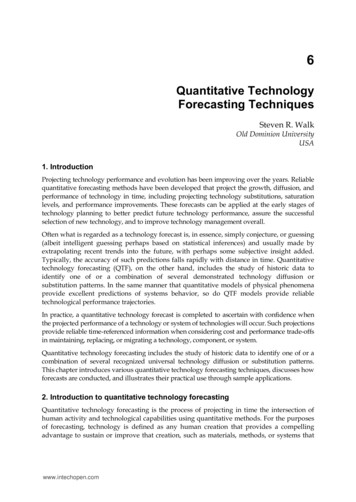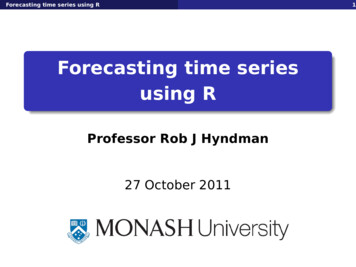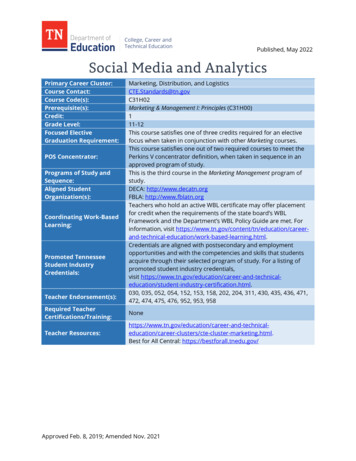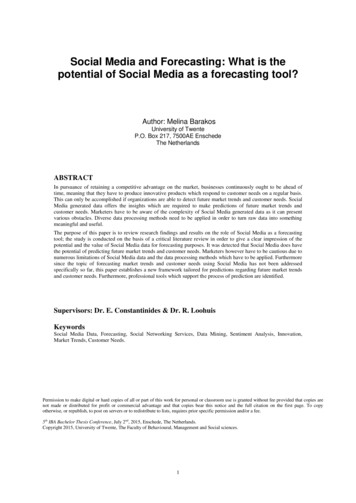
Transcription
Social Media and Forecasting: What is thepotential of Social Media as a forecasting tool?Author: Melina BarakosUniversity of TwenteP.O. Box 217, 7500AE EnschedeThe NetherlandsABSTRACTIn pursuance of retaining a competitive advantage on the market, businesses continuously ought to be ahead oftime, meaning that they have to produce innovative products which respond to customer needs on a regular basis.This can only be accomplished if organizations are able to detect future market trends and customer needs. SocialMedia generated data offers the insights which are required to make predictions of future market trends andcustomer needs. Marketers have to be aware of the complexity of Social Media generated data as it can presentvarious obstacles. Diverse data processing methods need to be applied in order to turn raw data into somethingmeaningful and useful.The purpose of this paper is to review research findings and results on the role of Social Media as a forecastingtool; the study is conducted on the basis of a critical literature review in order to give a clear impression of thepotential and the value of Social Media data for forecasting purposes. It was detected that Social Media does havethe potential of predicting future market trends and customer needs. Marketers however have to be cautious due tonumerous limitations of Social Media data and the data processing methods which have to be applied. Furthermoresince the topic of forecasting market trends and customer needs using Social Media has not been addressedspecifically so far, this paper establishes a new framework tailored for predictions regarding future market trendsand customer needs. Furthermore, professional tools which support the process of prediction are identified.Supervisors: Dr. E. Constantinides & Dr. R. LoohuisKeywordsSocial Media Data, Forecasting, Social Networking Services, Data Mining, Sentiment Analysis, Innovation,Market Trends, Customer Needs.Permission to make digital or hard copies of all or part of this work for personal or classroom use is granted without fee provided that copies arenot made or distributed for profit or commercial advantage and that copies bear this notice and the full citation on the first page. To copyotherwise, or republish, to post on servers or to redistribute to lists, requires prior specific permission and/or a fee.5th IBA Bachelor Thesis Conference, July 2nd, 2015, Enschede, The Netherlands.Copyright 2015, University of Twente, The Faculty of Behavioural, Management and Social sciences.1
advantage as it can convey insights into efficiently meetingconstantly changing consumer desires, communicated throughSocial Media (IBM, 2014). Ideally, if Social Media data isaccurately used as a predictive tool, organizations may wellproduce and deliver their customers innovative products andservices which fulfill their personal requirements and desiresbefore they themselves have thought about them seriously.1. INTRODUCTION1.1 Background InformationIn today’s digitalized world, data appears to be the currency ofthe twenty-first century. The main source of data is generatedand gathered online, primarily from customer’s activities onSocial Media platforms in which individual users communicate,share opinions and network with one another (Schoen et al.,2013). Businesses make use of tremendous quantities of datathat is collected from Social Networking Sites such asFacebook, Twitter, Youtube, Flickr, Instagram, various Blogplatforms and many others. The data collected from such sitescan be referred to as Social Media Big Data (Lazer et al., 2009).According to Gundecha and Liu (2012) "Social media givesusers an easy-to-use way to communicate and network witheach other on an unprecedented scale and at rates unseen intraditional media” (p.2). It is easier to actively participate inSocial Media rather than traditional media due to the fact thatfirstly, anyone can contribute (Yu & Kak, 2012), and secondlybecause the process of being involved in traditional mediachannels requires substantial means of time and input andbecause “it [social media] has torn down the boundariesbetween authorship and readership” (Zeng et al., 2010, p.13).Big Data collected from Social Media platforms reveals uniqueand easily accessible insights about customers’ interests, habitsand desires, over a large geographic spread at a significantlylow budget compared to traditional data collection methods.The advent of Big Data in Social Media totally changed thedepth and opportunities of analysis we had up to now intosomething much more powerful (Tufekci, 2014). Asur andHuberman (2010) claim that the content that is produced onSocial Media platforms is especially useful due to its “ease ofuse, speed and reach” (p. 1) and because “social media is fast,changing the public discourse in society and setting trends andagendas in topics that range from the environment and politicsto technology and the entertainment industry” (p. 1). Thisgigantic range of topics and interests as well as the largegeographic scope make it possible for organizations to analyzeevery type of industrial sector, country, gender, personal profileand any other attribute in which they wish to expand theirknowledge and expertise. According to Alexa Ranking,Facebook and Twitter are amongst the top 10 most visitedwebsites universally (Alexa Ranking, 2015). Twitter has 302million active monthly users with 500 million Tweets sent perday (Twitter, 2015) and a total of 645,750 million registeredusers by March 25, 2015 (Statistic Brain, 2015). Facebook has1,44 billion monthly active users as of March 31, 2015(Facebook, 2015). These statistics demonstrate Facebook andTwitters’ incredible growth and impact as well as the potentialvalue and large scope of the data collected from these sources.1.2 Research ProblemIn order to retain competitive advantage, businesses constantlyneed to be ahead of time, i.e. they are obliged to come up withbrand new, innovative products regularly. In order to be capableof accomplishing this goal, it is necessary to predict markettrends and customer needs with Social Media data. The reasonwhy Social Media based forecasting as a marketing strategyconcerning the prediction of future events and is still so rare isdue to the complex process of turning raw Social Media datainto something meaningful. The problem which firms are facingis that of inefficient evaluation of the data they have at hand,they essentially don’t know how to make the most effective andpractical use of the data in order to use it as a predictiveinstrument. Additionally, since this topic has not reached anadvanced level of general knowledge, organizations may notknow how beneficial Social Media generated data can be, whatit can be used for and how it can be applied. Since this is afairly untouched subject, one can’t assure 100 per cent that thedata from Social Media can always or even ever provide validand valuable information about the future. Consequently,understanding the value and potential of prediction as amarketing strategy and the limitations which Social Media BigData faces is vital when aiming to use the data as a forecastingdevice “in order to be successful and avoid false expectations,misinformation or unintended consequences” (Schoen et al.,2013, p. 528).Thus the research goal of this paper is to accumulate thepresent findings and experiences of Social Media data as aforecasting device in the form of a critical literature reviewin contemplation of providing a clear overview of this issue.The author is attempting to extend the knowledge of thepredictive power of Social Media data and to gain insights intodiscovering how valuable and how much potential the dataoffers for the (possible) prediction of future events, markettrends, behaviors and customers desires and needs. Existingpractices and techniques of data processing tools will beexamined and critically reviewed so that one may find clearevidence about the value and quality as well as the bestapproach of effectively using the data collected for the abovedeclared purpose. Hence, the following research question willbe addressed: What is the value and potential of social mediagenerated data to organizations for the purpose of predictingfuture market trends and customer needs?Moreover, the following sub questions will be answered withinthe critical literature review:Data generated from the above mentioned platforms providesexcellent opportunities for marketers, economists andstatisticians to predict market developments and customers’needs, established from Social Media data. Additionally, SocialMedia data has the potential of providing organizations with astrong marketing strategy with the ability of developinginnovative products and services by meeting customers’ wishesand needs. The power of prediction of Social Media has becomea much-talked about topic in the previous couple of years withincreasing popularity focusing on different aspects such aspredicting elections, the stock market, diseases and many othervariables which will be thoroughly discussed later on in thispaper. A prediction mechanism from Social Media data couldpotentially be an enormously valuable tool to organizations if itis handled appropriately; it could deliver a competitiveSub Question 1: What is or has already been predicted withSocial Media Data?Sub Question 2: How can Social Media Data be analyzed andbe transformed into meaningful Data? (Outline of forecastingmodels, tools, taxonomy of data processing methods)Sub Question 3: Can innovation be detected through SocialMedia data?Sub Question 4: What are the limitations of Social Mediabased forecasting according to critics?2
electronic search engines, primarily Google Scholar,ScienceDirect as well as the University of Twente onlinelibrary. Furthermore, the reference lists of selected, relevantarticles were scanned in order to access additional literaturewhich was not found during the original search procedure. Themost essential key search terms used with regard to discoveringapplicable literature were “Social Media (Data)”, “predictions”,“market trends“, “forecasting”, “data processing methods” and“innovation through Social Media”. The papers were classifiedas relevant or as not relevant after glancing over the abstractand the research goal. Focus was also on the date the literaturewas publicized. Recent articles were favored; nevertheless mostselected literature is not older than from 2009, since this topic isstill relatively fresh and undeveloped.1.3 Relevance of the TopicA paper in this explicit academic field is a valuable addition asthere are limited numbers of academic articles regarding thismatter which present an over-all guideline. This means thatthere are various articles which discuss the topic of SocialMedia and its predictive power; however most of them areabout a specific industry, organization or variable. This paperattempts to provide a general recommendation for marketersconcerning the practicality of Social Media generated data andit’s potential in acting as a predictive device for future markettrends and customer needs. The practical relevance of this paperis that it makes an effort to provide a suitable guideline for themarketing practices and strategies of an organization. Itessentially demonstrates whether or not it is worth investing theeffort (monetary and timely) of dealing with the complicatedprocedure of data processing methods. This paper attempts todemonstrate to organizations how to make valuable use ofSocial Media generated data and its predictive power to theiradvantage. Furthermore this general overview should assist inusing Social Media data as a forecasting tool especially formarket trends and future customer needs, since this topic hashardly ever been addressed in previous literature.This literature review is based on 53 academic articles/ researchpapers. Since the topic of Social Media based forecasting isfairly fresh, the majority of the articles that were analyzed arewhite papers or conference proceedings. Most articles stemfrom web based conferences such as the Conference ofComputer Communications or the International Conference onWorld Wide Web. Furthermore specific Social Media and DataMining Conferences were also part of the collection. Moreover,numerous articles stem from information systems, internetbased or general business journals such as the Journal ofInformation Management, Internet Research and BusinessHorizon.The paper is organized as follows. Firstly the methodology ofthis paper is outlined. Then, an extensive critical literaturereview will be conducted, in which key terms will be defined aswell as answering the above outlined sub questions in order tocontribute new insights about Social Media data and itspredictive potential. After defining key terms, an outline ofprevious studies and experiments of predicting the future withSocial Media generated data in different sectors will be given.Subsequently, the taxonomy of the methods and techniquesused in data processing for forecasting will be analyzed andoutlined as well as the limitations and critical views of SocialMedia based forecasting. Afterwards the question of Innovationthrough Social Media data is addressed. One of the last sectionsinclude an in depth discussion about the key findings which hasthe intention of answering the above stated research and subquestions. Afterwards a new framework is introduced with anew approach of using Social Media data for forecasting markettrends and customer needs followed by an outline ofprofessional tools which can support the process of SocialMedia based predictions. Lastly a conclusion will be givenincluding the limitations of this paper along with suggestionsfor further research.3. LITERATURE REVIEW3.1 Definition of Key TermsKey terms which will frequently be mentioned throughout thisliterature review, are defined in the following. The purpose ofthis small section is to ensure that the reader precisely knowswhat the author is referring to.3.1.1 Social MediaAs Social Media has been a significantly, widespread topic inprevious years, plenty of definitions are available. A few ofthem will now be outlined. According to Kaplan and Haenlein(2010) “Social Media is a group of Internet-based applicationsthat build on the ideological and technological foundations ofWeb 2.0, and that allow the creation and exchange of UserGenerated Content” (p. 61). Kietzmann et al. (2011) argue that“Social Media employ mobile and web-based technologies tocreate highly interactive platforms via which individuals andcommunities share, co-create, discuss and modify usergenerated content” (p. 241). Lastly, Constantinides & Fountain(2008) define Social Media as “a collection of open-source,interactive and user controlled online applications expandingthe experiences, knowledge and market power of the users asparticipants in business and social processes” (p. 232).Although all of these definitions sound somewhat diverse, inessence they convey a similar message; Social Media consistsof the following elements: openness, sharing, networking,communication, togetherness, co-creation or user-generatedcontent. These characteristics are important for determiningwhether or not the future can be predicted with Social Mediadata.2. METHODOLOGYThis paper takes the form of a critical literature review based onthe Emerald guide on ‘How to write a Literature review’. Theliterature review systematically analyzes established, applicablefindings and experiences from academic publications,conference proceedings and white papers in the field of SocialMedia and its potential to predict the future. This paper ispurely based on literature. The main focus in this study lies onanalyzing and outlining different taxonomies of data processingmethods and the possible areas of prediction. This informationwill primarily be assembled from academic publications orconference papers which have a strong focus on Social Media,Social and Computer Science. This paper attempts toaccumulate a range of relevant literature and opinions regardingthe issue of Social Media data acting as a predictive tool, inorder to reach clear and straight-forward conclusions, to fill thegap of knowledge and to provide a general overview concerningthis field of knowledge. The criterion for the paper selectionwas the focus of referring to Social Media data (whetherTwitter, Facebook or any other platform) as a predictive tool.The articles used in the literature review are derived from3.1.2 Social Networking Service (SNS)When speaking about Social Media “Social NetworkingServices” continually appears to be an accompanying term as itcan be seen as a subcategory of Social Media. According to Yu& Kak (2012) a Social Network can be defined as a “Socialstructure comprising of persons or organizations which usuallyare represented as nodes, together with social relations, whichcorrespond to the links among nodes” (p. 1). Social NetworkingServices (SNSs) are websites where users can register and form3
their own unique profile. There, they can interact, communicateand network with other users, share experiences and photos,find users who have similar interests (and add them as a ‘friend’to their own personal network), as well as forming discussiongroups which leads to the well-known user-generated content(Ahn et al., 2007; Yu & Kak, 2012). The most popular SocialNetworking Sites in the United States in March 2015 (based onmarket share of visits) were Facebook as number one, followedby Youtube, Google Plus and then Twitter (Statista, 2015). Thispaper will mainly focus on Facebook and Twitter as theseSocial Networking Sites are most applicable for the purpose ofthis research due to the valuable and ‘chatty’ data which can begathered from these communication channels. Table 1 presentsvarious Social Media Platforms alias Social NetworkingServices, split into a number of different categories in order todisplay the large scope and data potential.like the health sector, business or the movie industry. Asur andHuberman (2010) used Social Media (to be specific, Twitter) toforecast box-office revenues for movies, by observing the ratesat which movie tweets are created. Similarly, Oghina et al.(2012) established a model to predict movie ratings using SocialMedia data by observing the quantity of likes and dislikes onYouTube in combination with written expressions from Twitterregarding a selected movie. Zhang et al. (2011) as well asBollen et al. (2011) predicted Stock Market Indicators throughTwitter by watching out for emotional outbreaks and generalmoods. Achrekar et al. (2011) claim to have predicted flu trendswith Twitter data by making use of their own developed SocialNetwork Enabled Flu Trends (SNEFT) framework whichobserves messages posted on Twitter with reference to fluindicators. Likewise Colutta (2010) found a model to forecastinfluenza epidemics, also by analyzing Twitter influenza-linkedmessages. Moreover, Goel and Goldstein (2014) attempted topredict individual behavior with Social Networks, did howeverfind that there are also limits to the full prediction process.Another common prediction variable with Social Media data isSentiment by undertaking a Sentiment Analysis (Nguyen et al.,2012; Bifet & Frank, 2010). The almost certainly greatest themeup to now regarding predictions using Social Media data is inthe politics division, specifically in predicting electionoutcomes (Mejova et al., 2013; Metaxas et al., 2011; Sang &Bos, 2012; Boutet et al., 2012; Franch, 2013). Other predictingvariables include sales forecasts (Liu et al. 2007) and crimeforecasts (Wang et al. 2012 & Bendler et al. 2014). As can beseen, the models and zones of prediction have a wide rangewith numerous, diverse methods of analyzing and applyingdata. Unfortunately, no articles can be found which examine theuse of Social Media data for market predictions and customerneeds. Most of the above stated articles are assertive andoptimistic regarding their findings and the use of Social Mediadata as a predicting tool, presenting it as a relatively simple andstraight-forward procedure.Table 1. Different types of Social Media Platforms decha&Liu, 2012, Gandomi & Haider, 2015)TypesSocial NetworksBlogsMicroblogsSocial NewsSocialBookmarkingMedia sharingWikisReview SitesExampleFacebook, LinkedIn, MySpace,GoogleplusBlogger, WordPressTwitter, TumblrDigg, RedditDelicious, StumbleUponInstagram, YoutubeWikipediaYelp, Tripadvisor3.1.3 Data MiningData mining is predominantly important in predicting the futurewith Social Media Data. This is because Data miningtechniques can bring a lot of precious insights about humanconduct and communication (Barbier & Liu, 2011). DataMining essentially consists of applying mining techniques todiscover configurations or relationships which otherwise wouldhave not been found. Barbier & Liu (2011) came up with arespectable and simple definition: “data mining is identifyingnovel and actionable patterns in data” (p. 328). Data miningtechniques can help overcome typical problems with SocialMedia data which are for instance the size of the data set, thenoisiness and its dynamic nature (Barbier & Liu, 2011).Gundecha & Liu (2012) came up with a similar definition:“ to effectively handle large-scale data, extract actionablepatterns and gain insightful knowledge” (p. 1).Nevertheless there are critics out there who are in factquestioning this simple representation of data analysis andusage. Daniel Gayo-Avello (2012) is one of those critics – hehas published several articles concerning the above specifiedissue. He claims that no one has genuinely delivered a properprediction so far – everybody argues they would have been ableto accurately predict the correct results, fact is however, that all‘predictions’ were publicized after the final real-world resulthad already been published. Furthermore he debates that thedata collected on Social Media platforms could be biased whichmakes the results invalid or less valid (Gayo-Avello, 2012;Metaxas et al. 2011). This matter will be further consideredlater on in this literature review.3.3 Analysis of Social Media Data:Taxonomy of Data Processing Methods3.1.4 ForecastingSince ‘forecasting’ is likewise an often declared term in thisliterature review, it is important to shortly provide the readerwith a definition. The Business Dictionary defines forecastingas the following: “A planning tool that helps management in itsattempts to cope with the uncertainty of the future, relyingmainly on data from the past and present and analysis of trends”(Business Dictionary, n.d.). The words ‘forecasting’ and‘predicting’ are both used interchangeably in this paper.This is undoubtedly the most important fragment of the researchproblem this paper is attempting to solve and also generallyconcerning the topic of Social Media as a forecasting tool.Turning raw data into something meaningful and significant isessentially the most difficult part of the process. Organizationsthat wish to make Social Media based predictions should have awell-thought through Business Intelligence system whichsupports them at any point in time. Negash (2004) defines aBusiness Intelligence system as follows: “BI systems combinedata gathering, data storage, and knowledge management withanalytical tools to present complex internal and competitiveinformation to planners and decision makers” (p. 178). Thisdefinition demonstrates that a Business Intelligence systemessentially contains all the important elements which are3.2 Social Media as predictive toolEven though this field of interest is fairly fresh in the academicenvironment, there have been various experiments andpublished studies with a range of different outcomes which willbriefly be drawn out in the following. It seems that forecastingwith Social Media data is quite popular in different industries4
necessary for Social Media based predictions and thorough dataanalysis. The different data processing methods and ways ofanalysis which are outlined in the subsequent sections arecrucial components of practical Business Intelligence systems.This section is split into a number of parts for the purpose ofkeeping a systematic overview. Firstly, the characteristics ofSocial Media data will briefly be investigated in contemplationof examining why the process of analysis seems to be such acomplex task. Following on, various data processing methodswill be outlined, closely inspected and evaluated with theintention of coming up with a guiding framework including anordered means of using Social Media data for forecastingpurposes. Subsequently, the question of Innovation from SocialMedia data is addressed. Lastly, critical views and limitationsregarding the use of Social Media data for forecasting purposesare outlined.survey models are the correct way of collecting data fromSocial Media, due to a lack of accuracy and possible biasresponses. Furthermore, the application of a Sentiment Analysisis also an often seen instrument in the data analysis processwhich investigates the thoughts and feelings of users, applyingthese to arrive at selected conclusions.Gandomi & Haider (2015) suggest that the two most crucialinformation sources on Social Media platforms are Usergenerated content such as texts, videos and sentiments, and therelationships and interactions between the network participants.They claim that based on this classification of informationsources, Social Media analytics can be split into two maingroups, namely Content-based analytics and Structure-basedanalytics. Content-based analytics concentrate on theinformation which is published by users on Social Mediaplatforms such as texts, comments, videos, images etc.Structure-based analytics on the other hand, focuses on therelationships between Social Media users (Gandomi & Haider,2015). Similar to Structure-based analytics, Thiel et al. (2012)introduce a Network Analysis of Social Media data which alsofocuses on the relationships between individual users and theircommunication of various topics. Nodes and Edges are part ofthe representation of the structure of Social Media users andtheir relationships to one another. These relationships can bedetected and examined through different types of graphs.Furthermore, Gandomi & Haider (2015) also outline varioustechniques that provide useful material from the structure ofsocial networks such as community detection, social influenceanalysis and link prediction. These techniques are very usefulfor extracting Social Media based predictions. For instance,social influence analysis can investigate the sphere of influencea specific user has on a network, for example who acts as aleader and who acts as a follower in a specific network,implying that the leader has an increasing influence over therest of the network (Thiel et al., 2012; Gandomi & Haider,2015). Community detection can expose social patterns andlastly, links prediction techniques “predict the occurrence ofinteraction, collaboration, or influence among entities of anetwork in a specific time interval” (Gandomi & Haider, 2015p. 143).3.3.1 Social Media Data CharacteristicsSocial Media delivers a low-priced, rapid and largelyunstructured means of assembling data at a great scale and anextremely wide geographic scope (Schoen et al. 2013). SocialMedia data tends to appear mainly in the form of writtencontents (e.g. status updates on Facebook or Twitter, commentsin reviews or social groups, conversations with other users etc.),but also in the form of likes or dislikes, tags, hashtags(particularly on Twitter and Instagram), emoticons, videomessages, personal information (e.g. number of friends,citizenship, gender) and rating scores. Social Media data tendsto be noisy, vast, distributed and informal in nature(Kalampokis et al. 2013; Barbier & Liu, 2011; Gundecha &Liu, 2012) since it originates from various mediums and innumerous different forms which suggests that it ispredominantly very messy and unclear – consequently it isnecessary that this raw data is transformed into qualitative,valuable data. Moreover, the dynamic nature as well as theabsolutely enormous amount of data poses further challengestowards the use of Social Media data as a forecasting tool (Zenget al. 2010, Barbier & Liu 2011). Examples of unstructured datacomprise conversations, graphics, images, texts and videos –these can be turned into structured data by applying DataMining techniques and other analytical processes (Negash,2004). Essentially it is evident that Social Media data is difficultto analyze and evaluate due to four main characteristics:noisiness, size, unstructured and dynamic nature. Thesechallenges need to be overcome in order to convert disorderedand unclear data sets into something valuable to use them as aforecasting tool.3.3.2.1 Statistical MethodsGandomi & Haider (2015) suggest that “Predictive analyticstechniques are primarily based on statistical methods” (p. 143).Constructing Statistical models to predict the future is always auseful technique to adopt when scrutinizing and extracting datasets (Truvé, 2011). Almost every piece of literature which wasanalyzed during this literature review, at some point made useof statistical methods in their empirical research or discussedstatistical methods as a means of analysis for Social Media datain order to make sense of the data they have collected (Gilbert& Karahalios, 2009; Yu & Kak, 2012; Schoen et al., 2013;Tuarob & Tucker, 2013; Asur & Huberman, 2010; Lassen et al.,2014; Bandari et al., 2012; Achrekar et al., 2011). For instance,Jahanbakhsh & Moon (2014) analyzed political Tweets in orderto predict the 2012 U.S. election outcome. In order to reachconclusions, they also applied statistical methods; theycalculated the tweets frequency distribution, tweets mentionsdistribution and the hashtag distribution. The simplest and mostfrequent used technique is the
Social Media platforms is especially useful due to its "ease of use, speed and reach" (p. 1) and because "social media is fast, . predictive power of Social Media data and to gain insights into ing how valuable and how much potential the data offers for the (possible) prediction of future events, market .
